| NOTE: In an attempt to revamp & rearrange content in this website, there is now a newly developed section featuring various MF Nikkor lenses, please bookmark the new site for future updates. As for SLR bodies, please refer to: - Nikkormat, Nikon EM/FG/FG20, FM series, FE Series, Nikon FA, Nikon F, Nikon F2, Nikon F3 & Nikon F4 |
1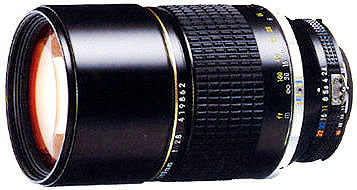
Nikkor 180mm f/2.8 ED
Ordered a manual focus 180 f2.8 ED lens a couple of weeks back for a friend and was told by Shriro Malaysia that this lens has long been 'deleted' from their inventory. Why ? I asked, Miss Rissa (Manager - Optical Product Division) said the demand for this lens has "slow down" a lot since the introduction of the AF 80-200mm f2.8 ED.
Not to relate the matter to the issue of slow growing numbers of serious photographers nowadays in photography. Personally, potential SLR users are from the current huge number of Point & Shoot users. How to attract and divert them to SLR photography is everybody's effort and responsibility. I am just doing my part here as a SLR user by running a site to present them with a bright, eventful, interesting and creative-filled way of SLR photography. You can say I am doing and pasting a 'DEMO' version of SLR photography to the P&S users. But I do hope this section can contribute a little extra in helping the promotion - since interchangeability of lenses is perhaps one of the strongest advantages it has over the P & S counterpart. One of the key definitive advantages of SLR photography is the ability to use diffferent types of lenses, which is far superior and flexible than any P&S model can offer. Not to mention you can use a true f2.8 lens instead of f12.8 on a P & S zoom !
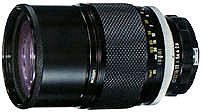 Perhaps the oldest I can locate, the original Non-ED version of this lens in colour. |
|
I have to admit this lens is featured here because it is used to be one of my favourites, and I am very comfortable to recommend it to anyone for consideration in your next lens purchase.
The 180mm Nikkor ED pictured above was a manual focus version. The current AF version is compact in size and light in weight. (The 1st generation of the AF 180mm f2.8S (IF) was being discontinued in August 95 and replaced with an upgrade, see picture below). The front lens element is where the ED (Extra Low Dispersion Glass) locates, and it was the only ED glass designated lens within a Nikkor below 200mm focal length. The use of an ED glass element helps very much to improved image quality, as optical abberations associated with longer focal length like chromatic aberration, is being minimized to an absolute minimal level. Thus, the correction of the blue and red spectrum within an image makes subjects with such colors more accurate, and also with a more natural color rendition. The lens comes with a handy built in telescopic lens hood, which is quite ideal for adverse backlighting situation to minimize chances of ghost and flare.
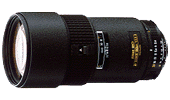 AF version of the 180mm f2.8D IF ED
AF version of the 180mm f2.8D IF ED
The minimum aperture diaphragm is considerate enough to be a smaller f-number of
f32 instead of f22. It closes down to 1.8m (around 6 ft) at its shortest focusing
distance. Due to a relative large aperture (f2.8), it accepts size 72mm filters.
While the picture angle of view is around 13° 40'. It is rather heavy (800g),
but projects a solid and quality feel.
Application for this lens can be very broad. I call it as an all rounder. Sports, action, stage, scenic, news and most convenient of all is, portraiture photography. The combination between longer (but render a more natural perpective) focal length (than the 105mm f2.5 Nikkor featured earlier) and the relatively large aperture (for creative depth of field control) makes this lens a perfect choice.
When mounted with a tele-converter, like the older TC200, will transform the lens into a 360mm f5.6 telephoto lens. Only thing to note is, when using aperture smaller than f11 at higher shutter speeds, it can yield occasional un-even exposures when a tele-converter is used.
The older manual lens which I am still using is rugged and solidly built. Although it is heavier and bulkier than the AF version, it is well balanced with a camera attached. Comparably, the original 1st version of the AF is kinda disappointing. Fortunately, Nikon realized it as users' complaints and eventually replaced with a more solidly built upgraded version. With the introduction of the 80-200 f2.8 (also went through few upgrades...), the popularity of the 180mm f2.8 has decreased. Well, if you have already owned an manual focus version, frankly, I won't see a necessity for a quick change to the AF lens. Only very recently, I noticed Nikon updated the lens to an AF-D - but still offering a Non-AFS version. But chances are slim as the priority has shifted to the 80-200mm zoom as reflected as the recent debut of the AF-S 80-200mm f2.8D lens. Although I don't think Nikon will upgrade this lens to AF-S (At least not in the near future, based on their slow reaction in lens development of the AF-I and AF-S) but I love to see a silent wave motor version to be incorporated - for telephoto lenses have a longer rotating arc on focusing, which consumes excessive energy and power for a state of continuous use. In short, I love to see Nikon improve or revamp their AF Nikkors to tackle the power efficiency issue or should I say their approach in AF technology as a whole. Whatever it is, this lens remains as one of my favourites due to its flexibility and great mobility it provides. Not to mention the overall superior optical performance it offers.
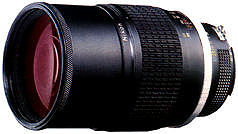
IS the non-ED version inferior when compared with the ED version ?
Not necessary true, Take a look at this:
 |
< Click here >
|
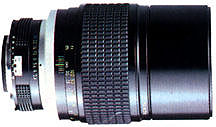
two older (Non- ED) version of the 180mm f2.8 during the seventies, compared with the earlier top view, these two improved a lot in its cosmestic..the lower version was prior to the release of the ED version.
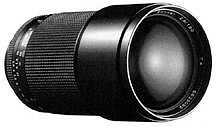
No one can explain why Nikon has chosen 180mm as its prime focal length (Other Japanese makes usually adopted 200mm instead, though Olympus has a 180mm f2...). Could the early days of this famed 180mm Olympia Sonnar a target for the Japanese to imitate ?
THIRD PARTY Opinion:
"....I think both the Olympus 180/2.8 and the Nikon 180/2.8
were inspired by the Zeiss Sonnar 180/2.8, which was introduced for the 1936 Olympics
in Germany. The Nikon and Olympus lenses are, technically, Sonnar-like designs, with
a positive group at the front, a negative group in the middle, and a weak positive
element at the back. The Olympus is more obviously a Sonnar type; Nikon has taken
the design and modified it more substantially. And the Nikon has *far* better correction
of chromatic aberration!..."
Michael
A. Covington - Artificial Intelligence Ctr - University
of Georgia
Author, ASTROPHOTOGRAPHY FOR THE AMATEUR
| Back | to Main Index Page of
Lenses
A pictorial history of:
Nikon, Hasselblad, Rollei.
![]()
* Message Board for your favourite lenses
Home - Photography in Malaysia
Copyright © 2000
leofoo® MIR Web Development Team
Credit: A combined contributing effort to
Michael Liu's Classic Nikkor lenses' site. A site dedicated
to a long lost friend on the
Net - Made with a PowerMac, broadcast with
a Redhat Linux
powered server. Cheers!
